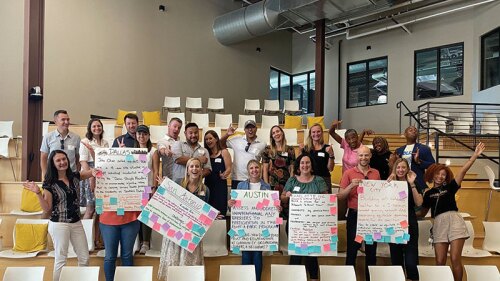Known for its long planning horizons and long-term capital investments in fixed, physical assets, the real estate industry is now faced with clients whose business strategies and space and leasing requirements are becoming harder to predict and more volatile. This new reality is adding tremendous pressure on an industry that is accustomed to growth that occurs in a linear fashion and dependent on traditional forms of occupancy such as long-term leases, according to a panel of experts on the intersection of real estate and technology held at the ULI 2015 Fall Meeting in San Francisco.
Moderated by ULI Global CEO Patrick L. Phillips, the panel took up the question of what new trends in technology are disrupting the status quo of real estate development. Framing the discussion was a new report released by ULI Europe that makes the critical point that real estate must adapt to an ever-evolving set of demands from 21st-century tenants, particularly as the pace of technological innovation quickens and shapes those demands.
According to Technology, Real Estate, and the Innovation Economy, real estate operators must adopt a “service provider” mind-set that is focused not only on managing an asset, but also on optimizing the tenant/owner relationship by offering a variety of funding, networking, and coaching services. Operators must also develop new business models, occupancy structures, and physical layouts that are flexible and adaptable to tenants’ needs. In addition, real estate owners, operators, and investors must align their interests with those of their tenants and clients in the form of venture capital and through developing an ecosystem of businesses that help each other within an asset.
Among other technology-related developments that will forever alter how real estate is built, developed, and managed are driverless cars, the unstoppable growth of e-commerce, and the rise of coworking platforms like WeWork. “There is an increasing chasm between the [real estate] industry and its customer base,” said David Mandell, cofounder and CEO of PivotDesk, a coworking platform. “We simply can’t predict our business the way we used to.”
Increasingly, Mandell said, clients or tenants are thinking primarily about how they can grow their business; and to this end, they are looking for flexible solutions when it comes to leasing, parking, and workspaces. They are also willing to seek out real estate partners who can support the vision for their business and may be willing to drop long-term partners who cannot. “I can grow my business in the way it needs to grow, not the way real estate needs it to grow,” Mandell said as he paraphrased this mind-set.
E-commerce, showing no signs of slowing down, has a tremendous need for warehousing space and fulfillment centers, three times that of traditional brick-and-mortar retail, according to Hamid Moghadam, CEO and chairman of Prologis and cochair of the 2015 ULI Fall Meeting steering committee. While new businesses may have fluctuations in their needs for space, technology can actually assist owners and operators make sure their assets are being used to their full potential, Moghadam said. “The good news is that you own scarce assets [that are well located], someone will be able to extract more utilization from them,” he said.
Autonomous vehicles, also known as driverless cars, also have the potential to remake the way cities, roads, and other infrastructure are designed and built. “We’re designing cars that are very different in a very short time horizon compared to real estate,” said Mark Platshon, senior adviser with BMW i-Ventures Fund and a longtime investor in and adviser to technology startups. “Some cities may lose 30 percent of their cars to Uber [the car-sharing service]. It’s going to change things.”
Truck- as well as car-makers are making great leaps forward in the realm of autonomous vehicles, which hold the promise of safer roads (no humans driving drunk, for example), greater fuel efficiency and cleaner air, as well as creating greater efficiency in logistics and day-to-day business operations. “There are natural affinity groups for [driverless cars]: the elderly, for example,” said Randy Rowe, ULI global chairman and chairman of Green Courte Partners LLC, a private equity real estate investment firm focused on niche real estate strategies. Overcoming resistance to autonomous vehicles will be a challenge, though, and will take longer to overcome than developing the technology itself, Platshon said.




